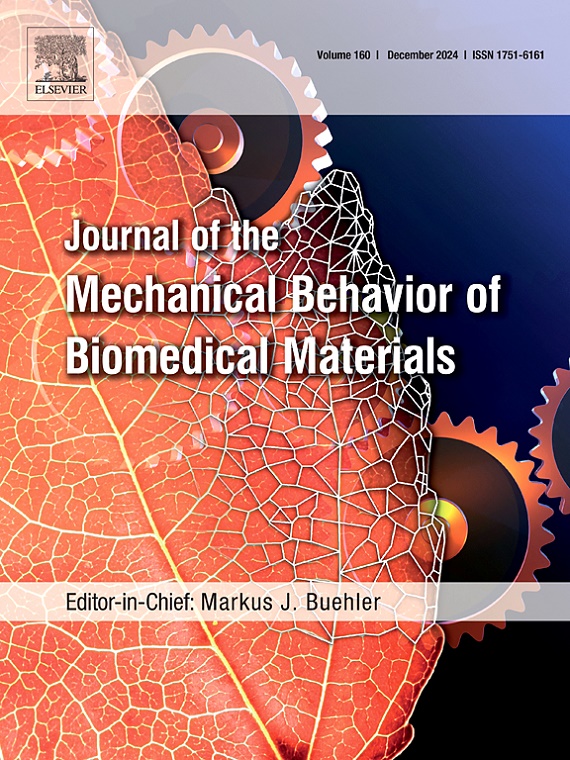Performance parity in cartilage repair: SPMK-g-PEEK versus cartilage–cartilage interfaces
IF 3.3
2区 医学
Q2 ENGINEERING, BIOMEDICAL
Journal of the Mechanical Behavior of Biomedical Materials
Pub Date : 2025-03-13
DOI:10.1016/j.jmbbm.2025.106964
引用次数: 0
Abstract
Effective fluid exudation and rehydration are essential for the low-friction function of healthy articular cartilage, facilitating interstitial fluid pressurisation, solute transport, and aqueous lubrication. However, current metallic biomaterials used in focal cartilage repair or hemiarthroplasty compromise this fluid-pressure dependent load support, leading to the erosion of the interfacing cartilage. This study investigates bioinspired hydrophilic 3-sulfopropyl methacrylate potassium salt (SPMK) polymer grafted onto a PEEK substrate (SPMK-g-PEEK) as a potential solution. SPMK-g-PEEK aims to mimic the natural tribology of cartilage by providing an aqueous low friction interface and polyelectrolyte-enhanced tribological rehydration (PETR), supporting fluid recovery and interstitial fluid pressurisation during cartilage sliding. We compare the tribological characteristics of physiological cartilage–cartilage interfaces, which rely on osmotic swelling and hydrodynamic tribological rehydration, with PETR enabled by SPMK-g-PEEK interfaces.
This study introduces a bespoke Fuzzy-PI controlled biotribometer. Employing a dual-phase testing method, static compression followed by sliding, allows simultaneous measurement of friction and cartilage strain recovery, indicative of interstitial fluid recovery following compressive exudation. Cartilage condyle, unfunctionalised PEEK, and SPMK-g-PEEK surfaces were investigated against flat cartilage plugs, which provide no hydrodynamic entrainment zone for tribological rehydration, and convex cartilage plugs, which create a convergent hydrodynamic zone for tribological rehydration. Matched cartilage–cartilage contacts exhibited low friction coefficients of 0.04 and strain recovery of up to 14% during the sliding phase. SPMK-g-PEEK surfaces sliding against convex cartilage plugs demonstrated similar strain recovery of 13% and reduced friction coefficients of 0.01, due to the combined effects of PETR and hydrodynamic tribological rehydration. In contrast, unfunctionalised PEEK surfaces, similar to current hard biomaterials employed in cartilage resurfacing, showed significantly higher friction and inhibited rehydration. SPMK-g-PEEK effectively mimics the physiological rehydration of connatural articular cartilage surfaces, highlighting its potential as a biomimetic material for cartilage resurfacing.
软骨修复中的性能平价:SPMK-g-PEEK与软骨软骨界面
有效的液体渗出和补水对健康关节软骨的低摩擦功能至关重要,有助于间质液体加压、溶质运输和水润滑。然而,目前用于局部软骨修复或半关节置换术的金属生物材料损害了这种流体压力依赖的负载支持,导致界面软骨的侵蚀。本研究研究了生物启发的亲水3-甲基丙烯酸磺丙基钾盐(SPMK)聚合物接枝到PEEK底物(SPMK-g-PEEK)上作为潜在的解决方案。SPMK-g-PEEK旨在通过提供水性低摩擦界面和聚电解质增强的摩擦学再水化(PETR)来模拟软骨的自然摩擦学,支持软骨滑动过程中的流体回收和间隙流体加压。我们比较了依靠渗透膨胀和流体动力再水化作用的生理性软骨-软骨界面与SPMK-g-PEEK界面实现的PETR的摩擦学特性。本研究介绍了一种定制的Fuzzy-PI控制生物摩擦计。采用两阶段测试方法,静态压缩后滑动,可以同时测量摩擦和软骨应变恢复,表明压缩渗出后间质液体恢复。研究人员将软骨髁、未功能化PEEK和SPMK-g-PEEK表面与扁平软骨塞和凸软骨塞进行了对比,前者没有为摩擦学再水化提供水动力夹带区,后者为摩擦学再水化提供汇聚水动力区。匹配的软骨-软骨接触在滑动阶段表现出低摩擦系数为~ 0.04,应变恢复高达~ 14%。由于PETR和流体动力摩擦学再水化的联合作用,SPMK-g-PEEK表面在凸软骨塞上滑动显示出类似的应变恢复~ 13%,摩擦系数降低~ 0.01。相比之下,未功能化的PEEK表面,类似于目前用于软骨表面修复的硬质生物材料,显示出明显更高的摩擦和抑制补液。SPMK-g-PEEK有效地模拟了自然关节软骨表面的生理再水化,突出了其作为软骨表面仿生材料的潜力。
本文章由计算机程序翻译,如有差异,请以英文原文为准。
求助全文
约1分钟内获得全文
求助全文
来源期刊

Journal of the Mechanical Behavior of Biomedical Materials
工程技术-材料科学:生物材料
CiteScore
7.20
自引率
7.70%
发文量
505
审稿时长
46 days
期刊介绍:
The Journal of the Mechanical Behavior of Biomedical Materials is concerned with the mechanical deformation, damage and failure under applied forces, of biological material (at the tissue, cellular and molecular levels) and of biomaterials, i.e. those materials which are designed to mimic or replace biological materials.
The primary focus of the journal is the synthesis of materials science, biology, and medical and dental science. Reports of fundamental scientific investigations are welcome, as are articles concerned with the practical application of materials in medical devices. Both experimental and theoretical work is of interest; theoretical papers will normally include comparison of predictions with experimental data, though we recognize that this may not always be appropriate. The journal also publishes technical notes concerned with emerging experimental or theoretical techniques, letters to the editor and, by invitation, review articles and papers describing existing techniques for the benefit of an interdisciplinary readership.
 求助内容:
求助内容: 应助结果提醒方式:
应助结果提醒方式:


